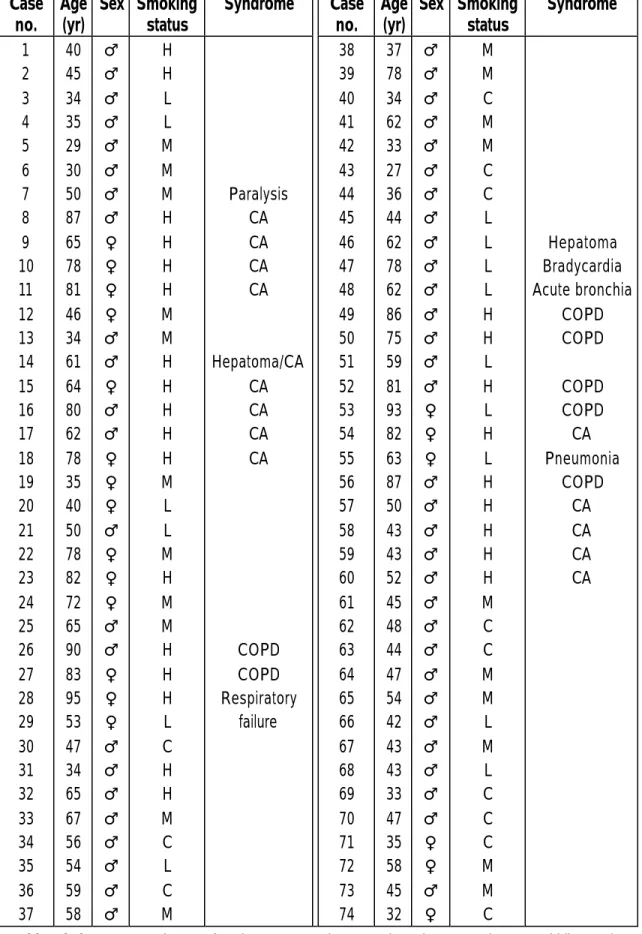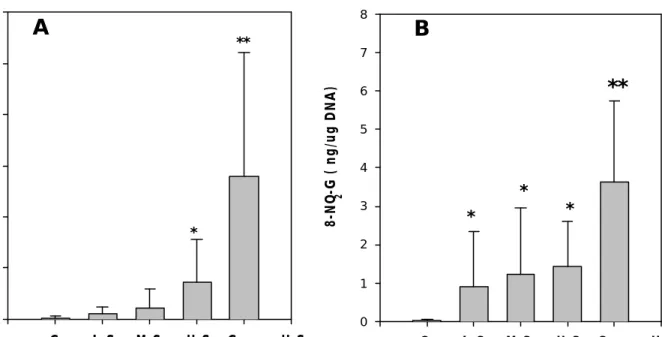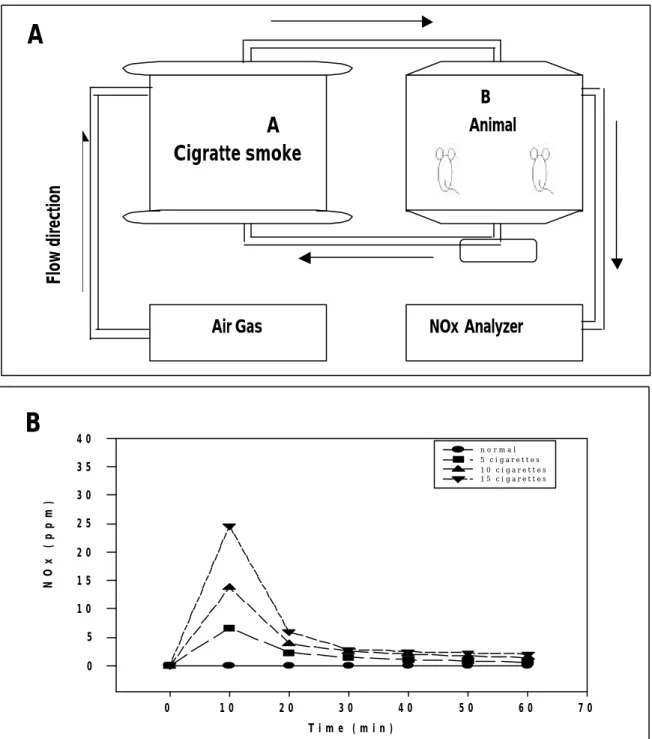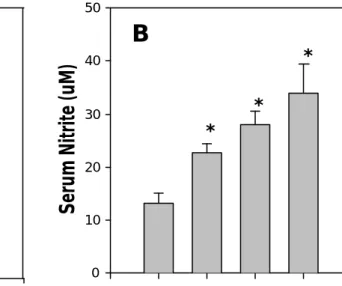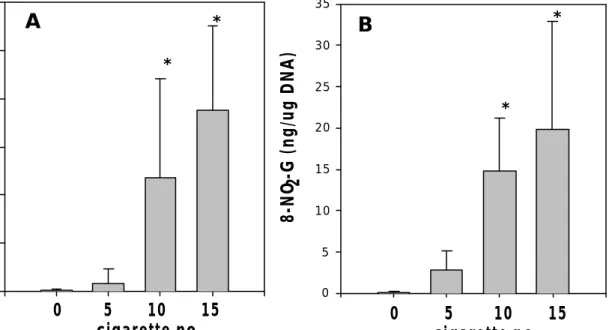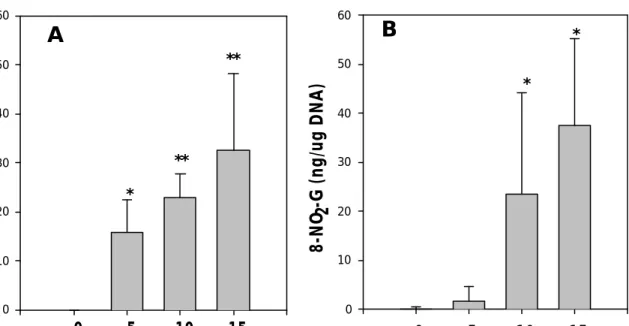目 錄
頁次 目錄 ……….. 1-2
縮寫表 ……….. 3 中文摘要……… 4-5
英文摘要……… 6-7 緒論及文獻整理………. 9-22 研究動機……… 23
實驗設計……… 24-25 實驗部份
(一) 血液及肺組織中
8-nitroguanine 之形成 ….. 26
壹、 材料及方法
一、實驗對象………
27二、實驗材料
一) 化學試藥……….…
27二) 儀器設備……….
28-29參、討論………
43-45肆、總結(Summary) ………
46伍、結果圖表(一)………
47-56(二)肺組織訊息傳遞及細胞週期蛋白之影響 …….
57文獻整理……… 58-64
壹、材料及方法
一、動物處理……….………
65二、實驗材料
一) 化學試藥………..
65二)
儀器設備……….
65-66三、實驗方法……….…..
67-74貳、結果………..
75-78參、討論………..
78-81肆、結果圖表(二)………..
82-92伍、總結 (Summary) ………...
93縮寫表 ( Abbreviation )
8-NO2-G 8-nitroguanine
8-OH-dG 8-hydroxy-deoxyguanosine L-S Light-smoker
M-S Middle-smoker H-S Heavy-smoker
Cancer-H-S Heavy-smoker with lung cancer NO Nitric oxide
NOx Nitrogen oxide
iNOS Inducible nitric oxide synthase ROS Reactive Oxygen species SOD Superoxide dimutase MDA Malondialdehyde
MAPK Mitogen-activated protein kinase JNK c-Jun NH2-terminal kinase PI-3-K Phosphatidylinositol-3-kinase PKC Protein kinase C
NF-κB Nuclear factor-κB
Rb Retinoblastoma gene product
STATs Signal transducer and activated of transcription CDK Cyclin-dependent kinase
Bcl-2 B cell lymphomal leukemia-2
中文摘要
在過去的實驗中已發現氣體性 NOx 在人類肺纖維細胞中
(MRC-5)中能夠誘導產生攻擊 DNA 的特異性產物---8-NO2-G。然而,
香菸也會產出高濃度的 ROS 及 NOx,但是否同樣會在吸煙者及煙霧中 大白鼠產生,仍未被證實。為了證實在吸煙者血液中的 DNA 是否受 到 NOx 的 damage,我們選用 15 位輕度吸煙者(L-S), 每天 1 包,少 於 5 年;21 位中度吸煙者(M-S),每天 2 包,吸煙 5-10 年;12 位重 度抽煙者(H-S),每天大於 2 包,吸煙超過 10 年;14 位重度抽煙的 肺癌患者(Cancer H-S)及 12 位不抽煙的健康者作為正常對照組,比 較這些不同程度吸煙者其血中 8-OH-dG 和 8-NO2-G 形成的情形。果然,
血中白血球數目、8-OH-dG 、8-NO2-G、血清中 nitrite 濃度及脂質過氧 化產物 MDA 平均值,都隨著吸煙程度增加而增加,且有明顯劑量效 應;而血清中抗氧化酵素SOD 的活性亦隨之增加、然而 GSH peroxidase 的活性則是降低。
在動物實驗裡,將大白鼠分別曝露 5、10、15 支香煙煙霧中,每 天 2 次、每次 30 分鐘、持續 1 個月,斷頸取其肺組織及血液分析 DNA 中 8-NO2-G 的量,與對照組比較,結果有明顯劑量效應,其量分別為 0.17、1.65、23.50 和 37.58 ng/μg;且在血中白血球數目和血清中 nitrite 的濃度也都隨之增加。因此,香菸中的 NOx 或曝露而增加的內生性 NO,所造成的 DNA 損傷(8-NO-G 的形成),可能與致癌作用有關。
伴隨發炎現象或肺氣腫的產生。從以上證據顯示 cigarette smoke 引起 肺組織之過氧化作用,造成肺組織之傷害,其作用可由 8-OH-dG 及 8-NO2-G 的形成來確認。
我們運用西方墨點法測定相關的訊息蛋白,進一步證實煙霧中的 NOx 在肺組織活化 NF-κB 及 iNOS 產生 NO 後,經由活化 MEKK-1、JNK / P38 訊息路徑,造成轉錄因子 ATF-2 蛋白表現增加,這個證據顯示,
可能與煙霧中 NOx 造成肺組織癌化有關;除此對於 Raf / MEK1 路徑,
則不相關。
關鍵詞:香煙、8-OH-dG、8-NO2-G、氮氧化物、訊息傳遞
Abstract
Our previous studies have shown that 8-nitroguanine (8-NO2-G) could serve as a specific marker of DNA damage induced by gaseous nitrogen oxides (NOx). Furthermore, we investigated the potential of cigarette smoking containing NOx to generate 8-NO2-G in smoker and smoke exposed rats. To evaluate the effect of cigarette smoking on the NOx-caused DNA damage in blood samples of smokers, we compared the levels of 8-NO2-G in blood samples obtained from 15 light-smokers (L-S, less than 1pack/day), 21 moderate-smokers (M-S, 1-2 pack/day for 5-10 years), 12 heavy-smokers (H-S, over 2 packs/day for 10 years), 14 heavy smokers with lung cancer (cancer H-S) and 12 non-smoking healthy controls. The mean level of 8-NO2-G in blood from groups of L-S, M-S, H-S and cancer H-S, was higher than that of the 8-NO2-G levels and serum nitrite in smokers. Furthermore, in animal experiment, a dose-dependent increase in 8-NO2-G was observed in the DNA of rat lung and blood DNA after exposure to cigarette smoke twice a day, for 1 month. The level of 8-NO2-G is 0.17, 1.65, 23.50 and 37.58 ng per μg lung DNA for rat exposed with cigarette smoke from 0, 5, 10, 15 cigarettes, respectively. It was also found that white blood cell (WBC) count and serum concentration of nitrite increased after the smoke exposure. It is postulated that cigarette smoke-induced DNA damage (8-NO2-G formation) by exo- and endogenous NOx may constitute an important pathway in lung carcinogenesis.
degree of emphysema is noted in the alveolar space.
However, this project is to explore the tumor promoting effect of NOx on lung tumorgenesis.
Key word: cigarette smoke、8-OH-dG、8-NO2-G、NOx、signal transduction
緒 論
流行病學的研究顯示,吸煙會造成人類各種癌症 ( 1, 2,3,4 )。然 而,其致癌的分子機制仍不清楚。香煙已被證實含有 3,800 種以上的 有害成份,大都具有致突變和致癌活性 ( 5 )。 高溫燃燒下的香煙能 夠產出高濃度 reactive oxygen species (ROS) 和 nitrogen oxides (NOx) ( 6- 8 ) 可能與致癌作用有關(9)。先前的研究指出吸煙也會造成一些慢 性病,與 free radicals 的形成有關 ( 8, 10, 11 )。 分子毒理的研究已證 實吸煙會使 heme oxygenase 的表現增加 ( 12 ) 及改變轉錄因子 c-fos gene 的調控 ( 13 )。而本實驗室之前也發現,香煙的曝露,所形成的 氧化壓力( oxidant stress),使得 iNOS 和 c-fos 受到刺激,而誘導一連串 protein tyrosine phosphorylation and MAP kinases 的活化,而促進 lung carcinogenesis ( 14 )。從先前的研究指出,香煙中直接攻擊 DNA damage 的成分,包括已被報告 reactive agent ( 15, 16) 和一些未被證實的成分 ( 17 )。 從 human 和 rodent cells 培養,知道吸煙造成 DNA 單股斷鏈 ( 18-24 )。先前也有報導指出,隨著吸煙程度的增加,在人類白血球和 肺組織中 8-deoxy-guanosine (8-OH-dG) 的生成和它的修補活性也隨之 增加 ( 25, 26 )。 最近也證實,香煙中含有 peroxynitrite ( 27 ),在 in vitro 能和 guanine 及 DNA 作用形成 8-nitroguanine (8-NO2-G)( 28, 29 )。 之前 報導也指出香煙氣體相 ( gas phase)含有高濃度 nitrogen oxides(NOx)
( 6 )。我們實驗室最近也發現,氣體 NOx 在人類肺纖維細胞(MRC-5)
文獻整理
【台灣之肺癌流行病調查】
肺癌在台灣之發生率已居於男性第二,女性第一。男性的癌症死 亡率,僅次於肝癌;女性則已超過子宮頸癌,(如附表一),且台灣地 區的肺癌發生率再三十年來增加近八倍,是增加最快的癌症之一。按 其增加的速率估計,在二十一世紀初可能就會成為國人最重要的癌 症。在基礎醫學、臨床醫學及流行病學上,都有一定的證據顯示吸菸 是肺癌最重要的因子,二手菸暴露也被證實為肺癌之危險因子,然而 其致肺癌之分子機制仍不甚瞭解。 ( 31 )
【香菸的煙塵】
菸葉內含有纖維、澱粉、蛋白質、醣類、碳氫化合物、酚、脂肪 酸、脂醇、無機物等複雜成分,當然所吸入的並非菸葉而是煙塵,其 成分已完全不同,有氣體相(gas phase)、焦油相(tar phase),目前 已被發現4000 種以上或強或弱的致癌物質(32)。
(一)氣體相(gas phase):
人在抽煙時將各種氣體與煙塵一起吸入,其主要成分為氮、
氧、二氧化碳、一氧化碳、氫、氬、碳氫化合物等,其中許多成 分雖含量極微,仍會刺激呼吸器官,如甲醛、乙醛、丙烯醛、甲
活息息相關,NO 之存在首先由環境汙染物分析,但對人類健康 甚少描述,只有從製造硝煙的工人的一些症狀,如對鼻之刺激、
肺部不適等(33),而 NO2則較具毒性,濃度大於150 ppm 將造成 肺水腫及嚴重的肺纖維化。在動物研究中,其LD50約為25 ppm,
濃度在4-20 ppm 將造成動物肺發炎、上皮細胞傷害及 brochiolitis
(34)。
吸煙也會形成 free radical,其中每呼出一口煙其中含有 1014 個自由基,包含 NO.、NOO.、H2O2、OH.、O2.-、ONOO-等有機及 無機的自由基。氣相中自由基會攻擊血漿中的蛋白質,造成一 些慢性病。
(二)焦油相(tar phase):
焦油是指香菸煙霧的總和微粒物質。含有27%的水分,以及
酯、脂醇、砷、鉀、蛋白質等有機、無機物,這些化合物吸入肺 內大都對肺無害,但也有對呼吸器官具有刺激作用的物質,如有 機酸、丙三醇、丙二醇、乙醇、酮、酚,特別是尼古丁(nicotine)、
亞硝化產物及具有發癌性的芳香族碳氫化合物(PAH)(polycyclic aromatic hydrocarbons)(如附表三、四)。其中每公克焦油含有 1018 個自由基,所含的自由基大多數為有機的自由基,如 OH.、H2O2、 catechols、hydro quinones、semiquinone 等穩定的自由基,香煙中並 無穩定的氧自由基,而是燃燒時氣相中 O2.-/ H2O2 /OH.會和焦油相
吐、頭痛、血壓上升及呼吸急促等,尤其當濃度高達30-60 m 會 導致人類死亡(37);尼古丁(nicotine)除了會提高細胞發生 SCE 的頻率,誘使染色體變異(38),以及改變細胞生命週期(cell cycle),使細胞停滯在 G1 期,進而抑制細胞生長。
香煙中亞硝化產物 N’-nitrosonornicotine(NNN)及 4-(methylnitro- samine)-1-(3-pyridyl)-1-butanone(NNK)會誘使實驗動物發生、
鼻腔及食道癌等(39)。
在 18 世紀英國的煙囪清掃工及煤焦油工廠的工人,有高癌 症罹患率。其後從煙囪的煙塵及煤焦油中,檢驗出芳香族碳氫 合物,將之塗敷於實驗動物皮膚及皮下注射,研究其發癌性, 其 中 Benz(a) Pyrene 發癌性最強。而且也發現煙塵焦油中某些物質,
其本身未具有發癌作用,但與發癌性物質在一起會增加致癌作 用(32)。
【香煙危害人體健康至鉅】
究竟香煙中的有害物質可能與哪疾病有關?(如附表五),及 從吸煙對疾病死亡率的影響可看出 ”吸煙者發生肺癌的相對危 險性是不吸煙者的12 倍左右,而重度吸煙者的相對危險性更高 達 15-25 倍左右” (如附表六)。且香煙和肺癌有明顯的劑量效應關 係(dose-response relationships),危險數會隨著吸煙的年數、每
而香菸煙霧的成份分別被描述成引起腫瘤的啟始者(initiators)、
促進者(promoters)、輔癌物(cocarcinogens)和特定器官致癌物
(41)。
抗氧化相關酵素
身體的另一個抗氧化防禦系統為抗氧化相關酵素,包括:GSH peroxidase、GSH reductase、GST、SOD、catalase。這些抗氧化相關酵素 可協同小分子抗氧化物一起保護細胞抵抗氧化壓力(42)
GSH peroxidase、SOD 可將超氧陰離子(O2-)轉變成氫過氧化物
(H2O2),catalase 再將 H2O2還原為水(43),GSH reductase、也以 GSH 為 受質還原氫過氧化物(H2O2)、脂質過氧化物及有機氫過氧化物使其轉 變為水或醇類物質,GSH 被氧化後,GSH peroxidase 可將其再還原。
另一方面 GSH peroxidase 也可使 GSH 和身體的有毒物質結合,增加有 毒物質的溶解性,促進其排洩。
抗氧化相關酵素與自由基的形成及可能造成之危害(如附表八)。
附表一
台灣地區十大癌症死亡統計
合 計 男 性 女 性 88 年
排名 順位
癌症死亡原因 87 年 排名
癌症死亡原因 87 年 排名
癌症死亡原因 87 年 排名
1 肺癌 2 肝癌 1 肺癌 1
2 肝癌 1 肺癌 2 肝癌 2
3 結腸直腸癌 3 結腸直腸癌 3 結腸直腸癌 3
4 胃癌 4 胃癌 4 女性乳癌 5
5 女性乳癌 6 口腔癌 5 子宮頸癌 4
6 子宮頸癌 5 食道癌 6 胃癌 6
7 口腔癌 7 鼻咽癌 7 膽曩癌 9
8 攝護腺癌 8 非何杰金淋巴癌 8 胰臟癌 8
9 非何杰金淋巴癌 9 攝護腺癌 9 非何杰金淋巴癌 7
10 胰臟癌 10 胰臟癌 10 白血病 10
資料來源 :行政院衛生署
附表二 香煙中的主要氣相(vapor phase)成分
Table 2. Major constituents of the vapor phase of the mainstream smoke of nonfilter cigarettes
Compound Concentration/cigarette
( % of total effluent ) Nitrogen
Oxygen Carbon dioxide Carbon monoxide Water
Argon Hydrogen Ammonia
Nitrogen oxides (NOx) Hydrogen cyanide Hydrogen sulfide Methane
Other volatile alkanes (20)a Volatile alkenes (16) Isoprene
Butadiene Acetylene Benzene Toluene Styrene
Other volatile aromatic hydrocarbons (29) Formic acid
Acetic acid Propionic acid Methyl formate Other volatile acids (6) Formaldehyde Acetaldehyde Acrolein
Other volatile aldehydes (6) Acetone
Other volatile ketones (3) Methanol
Other volatile alcohol (7) Acetonitrile
Other volatile nitriles (10) Furan
Other volatile furans (4) Pyridine
Picolines (3) 3-Vinylpyridine
Other volatile pyridines (25) Pyrrole
Pyrrolidine N-Methylpyrrolidine
280-320 mg ( 56-64 % ) 50-70 mg ( 11-14 % ) 45-65 mg ( 9-13 % ) 14-23 mg ( 2.8-4.6 % ) 7-12 mg ( 1.4-2.4 % ) 5 mg ( 1.0 % ) 0.5-1.0 mg 10-130 µg 100-600 µg 400-500 µg 20-90 µg 1.0-2.0 mg 1.0-1.6 mgb 0.4-0.5 mg 0.2-0.4 mg 25-40 µg 20-35 µg 6-70 µg 5-90 µg 10 µg 15-30 µg 200-600 µg 300-1700 µg 100-300 µg 20-30 µg 5-10 µgb 20-100 µg 400-1400 µg 60-140 µg 80-140 µg 100-650 µg 50-100 µg 80-180 µg 10-30 µg 100-150 µg 50-80 µgb 20-40 µg 45-125 µgb 20-200 µg 15-80 µg 7-30 µg 20-50 µgb 0.1-10 µg 10-18 µg 2.0-3.0 µg
附表三 香煙中的主要微粒子成分
Table 2. Major constituents of the particulate matter of the mainstream smoke of nonfilter cigarettes
Compound µg/Cigarette
Nicotine Nimicotine Anatabine Anabasine
Other tobacco alkaloids (17)a Bipyridyla (4)
n-Hentriacontane (n-C31H64) Total nonvolatile hydrocarbons (45)b Naphthalene
Naphthalenes (23) Phenanthrenes (7) Anthracenes (5) Fluorenes (7) Pyrenes (6) Fluoranthenes (5)
Carcinogenic polynuclear aromatic hydrocarbons (11)c Phenol
Other phenols (45)b Catechol Other catechols (4)
Other dihydroxybenzenes (10) Scopoletin
Other polyphenols (8)b Cyclotenes (10) b uinones (7) Solanesol Neophytadienes (4) Limonene
Other terpenes (200-250)b Palmitic acid
Stearic acid Oleic acid Linoleic acid Linolenic acid Lactic acid Indole Skatole Other indoles (13) Quinolines (7) Other aza-arenes (55) Benzofurans (4)
Other O-heterocyclic compounds (42) Stigmasterol
Sitosterol Campesterol Cholesterol Aniline
100-3000 5-150
5-15 5-12 n.a.d 10-30 300-400100 b
2-4 3-6b 0.2-0.4b 0.05-0.1b 0.6-1.0b 0.3-0.5b 0.3-0.45b 0.1-0.25 80-160 60-180b 200-400 100-200b 200-400b 15-30
n.a.
40-70b 600-1000 0.5
200-350 30-60
n.a.
100-150 50-75 40-110 150-250 150-250 60-80 10-15 12-16 n.a.
2-4 n.a.
200-300 n.a.
40-70 30-40 20-30 10-20 0.36
附表四 香煙和煙霧中的致癌物
Table 4. Carcinogens in tobacco and cigarette smoke
IARC evaluation evidence of carcinogenicitya
Compound In processed
tobaccob (per gram)
In mainstream smokeb (per cigarette)
In laboratory
animals In humans
PAHsc
Benz(a)anthracene Benzo(b)fluoranthene Benzo(j)fluoranthene Benzo(k)fluoranthene Benzo(a)pyrene Dibenz(a,h)anthracene Dibenzo(a,I)pyrene Dibenzo(a,l)pyrene Indeno(1,2,3-cd)pyrene 5-Methylchrysene Aza-arenes Quinoline Dibenz(a,h)acridine Dibenz(a,j)acridine 7H-Dibenzo(c,g)-carbazole N-Nitrosamines
N-Nitrosodimethylamine N-Nitrosoethylmethylamine N-Nitrosodiethylamine N-Nitrosopyrrolidine N-Nitrosodiethanolamine N-Nitrosoarcosine N-Nitrosonornicotine 4-(Methylnitrosamino)-3- (pyridyl) -1-butanone N’-Nitrosoanabasine N-Nitrosomorpholine Aromatic amines 2-Toluidine 2-Naphthylamine 4-Aminobiphenyl N-heterocyclic amines AaC
MeAaC IQ
0.1-90 ng
ND-215 ng
5-50 ng 50-3000 ng 20-120 ng 0.3-89 µg 0.2-7 µg 0.01-1.9 µg ND-690 ng
20-70 ng 4-22 ng 6-21 ng 6-12 ng 20-40 ng 4 ng 1.7-3.2 ng present 4-20 ng 0.6 ng 1-2 µg 0.1 ng 3-10 ng 0.7 ng 0.1-180 ng 3-13 ng ND-2.8 ng 3-60 ng ND-68 ng 0.12-3.7 µg 0.08-0.77 µg 0.14-4.6 µg
30-200 ng 1-22 ng 2-5 ng 25-260 ng 2-37 ng 0.26 ng
Sufficient Sufficient Sufficient Sufficient Sufficient Sufficient Sufficient Sufficient Sufficient Sufficient Sufficient Sufficient Sufficient Sufficient Sufficient Sufficient Sufficient Sufficient Sufficient Sufficient Sufficient Limited
Sufficient Sufficient Sufficient Sufficient Sufficient Sufficient
Probable
Inadequate Sufficient Sufficient
Probable
附表四 香煙和煙霧中的致癌物 (接續)
Table 4. Carcinogens in tobacco and cigarette smoke(continued)
IARC evaluation evidence of carcinogenicitya
Compound In processed
tobaccob (per gram)
In mainstream smokeb (per cigarette)
In laboratory
animals In humans
Miscellaneous organic compounds 1,3-Butadiene
Isoprene Benzene Styrene Vinyl chloride DDTe DDEe Acrylonitrile Acrylamine 1,1-Dimrthylhydrazine 2-Nitropropane Ethyl carbamate Ethylene oxide Di(2-ethylhexyl)phthalate Furan
Benzo(bfuran Inorganic compounds Hydrazine Arsenic Nickel Chromium Cadmium Lead Polonium-210
20-13,400 ng 7-960 ng
60-147 µg 310-375 ng Present
14-51 ng 500-900 ng 2000-6000 ng 1000-2000 ng 1300-1600 ng 8-10µg 0.2-1.2 pCi
20-75 µg 450-1000 µg 12-70 µg 10 µg 1-16 ng 800-1200 ng 200-370 ng 3.2-15 µg present 0.73-1.21 µg 20-38 ng 7 µg 20 µg 18-30 µg present 24-43 ng 40-120 ng 0-600 ng 4-70 ng 41-62 ng 35-85 ng 0.03-1.0 pCi
Sufficient Limited Sufficient Sufficient Sufficient Sufficient Sufficient Sufficient Sufficient Sufficient Sufficient Sufficient Sufficient Sufficient Sufficient Sufficient Sufficient Inadequate Sufficient Sufficient Sufficient Sufficient Sufficient
Probable Possible Sufficient Possible Sufficient
Limited Probable
Limited Inadequate Inadequate Inadequate Sufficient Limited Sufficient Limited Inadequate Sufficient
aNO designation indicates that IARC has not evaluated the compound.
bND, not detected.
cPAH, polynuclear aromatic hydrocarbons: AaC, 2-amino-9H-pyrido(2,3-b)indole; MeAaC, 2-amino-3-methyl- -9H-pyrido(2,3-b)indole; IQ, 2-amino-3-methylimidazzo(4,5-b)quinoline; Trp-P-1, 3-amino-1,4-methyl-5H-pyrido (4,3-b)indole;Trp-2, 3-amino-1-methyl-5H-pyrido(4,3-b)indole; Glu-P-1, 2-amino-6-methyl(1,2: -a: 3’, 2’-d) imidazole; Glu-P-2, 2-aminodipyrido(1,2-a:3’, 2’-d)imidazole; PhlP, 2-amino-1-methyl-6-phenylimidazo(4,5-b) pyridine.
dThe 4th report of the Independent Scientific Committee on Smoking and Health (1988) published values for the 14 leading British cigarettes in 1986 (51.4% of the market) of 20-1050 µg/cigarette (mean 910 µg) for acetaldehyde.
eDuring the last decade, DDT and DDE have been drastically reduced in U.S. cigarette tobacco (<60 ng and
< ng).
附表五 吸煙導致相關疾病及可能作用劑
Table 5. Probable causative agents for cigarette smoke-related disorders
Disorder Contributing agents Possible enhancing
or associated agents Cardiovascular disease
Cardiovascular disease
Chronic obstructive lung disease Lung and larynx cancer
Oral cavity cancer
Esophageal cancer Urinary bladder Pancrease cancer
Major : nicotine
Minor: secondary Nicotiana alkaloids, Flavor components
Major: carbon monoxide, nitrogen oxides, Hydrogen cyanide, “tar”
Minor: cadmium, zinc, carbon disulfide Hydrogen cycanide, volatile aldehydes, Nitrogen oxides, carbon monoxide, ”tar”
Major: PAH, NNK
Minor: 210 polonium, formaldehyde, Acetaldehyde, butadiene, metals(Cr, Cd, Ni) Major: NNN, NNK
Minor: PAH NNN
4-Aminobiphenyl, 2-naphthylamine, other aromatic amine
NNK, NNAL
Acetaldehyde(?)
Nicotine Alkylating species
Catechol, tumor promoters
Acetaldehydes, Diet, Alkylating species Herpes simplex, irritation Ethanol, Diet Ethanol, diet
Diet Note. Abbreviations: PAH, polynuclear aromatic hydrocarbons; NNK,
4-(methylnitrosamine)-1-(3-pyridyl)-1-butanone; NNN, N’-nitrosonornicotine; NNAL, 4-(methylnitrosamino)-1-(3-pyridyl)-1-butanol.
References: U.S. Depentment of Health and Human Services (1982, 1983, 1984, 1988, 1989); International Agency for Research on Cancer (1986); Horffmann and Hecht (1989).
( Jounal of Toxicology anf Environmental Health, 50, 307-364, 1997)
附表六
吸菸對疾病死亡率的影響
不吸菸 吸紙菸 整體死亡率 1 1.66
肺癌 1 12.39 口腔癌 1 8.23 咽喉癌 1 9.85 食道癌 1 3.97 膀胱癌 1 2.15 胰臟癌 1 2.07 冠狀動脈疾病 1 1.54 慢性阻塞性肺疾 1 11.70 主動脈瘤 1 4.96
資料來源:1996 年美國癌症學會(American Cancer Society)
;癌病預防研究第二報
附表七
吸菸數量及年限與肺癌發生率
每日吸菸量 (支)
吸菸
年限 1-10 11-19 20 21-30 30+ 21-30 2.9 6.7 13.6 18.4 18.9 31-40 7.9 19.2 19.2 26.5 25.3 41-70 10.0 17.0 25.1 34.3 38.3
資料來源:聲洋防癌之聲85 年 3 月春字號
附表八
自由基的形成及可能造成之危害
O2
O2.- SOD H2O2 OH. DNA damage
Lipid peroxidation Protein oxidation
NO. Peroxynitrite
GSH Se GSSG
H2O H2O O2
catalase
Defence
( 摘 自 TIBS Vol.21 83-86 1996 )
研究動機
(ㄧ) NO在生物體內可與superoxide產生peroxynitrite。在過去實驗中已 發現空氣及煙霧中之NOx在人類肺纖維細胞( MRC-5)中產生
peroxy-nitrite也可誘發iNOS產生內生性NO,進一步發現NOx攻擊 DNA的 產物為8-NO2-G。
在 cigarette smoke fraction 中也發現 peroxynitrite 的產生,peroxynitrite 已 被 證明具有神經毒性,上皮細胞傷害及脂質過氧化作用等。
peroxynitrite 也被證實為一種 oxidative stress-inducing compound,能造成人 類細胞 DNA 傷害。但此是否煙霧中 NOx 造成肺癌的原因,仍未被證 實。本研究將證實是否吸煙者及煙霧中大白鼠血液或肺組織中,以 HPLC-ECD 分析同樣能有 NOx-specific DNA adduct-- 8-NO2-G 的形成,此 adduct 無論在致肺癌機轉或鑑識 NOx 暴露上均有其價值。
(二) 先前的研究顯示氣體性 NOx 能夠活化 iNOS,本研究想進一步探 討煙霧致病之可能分子機轉(包括活化增生訊息傳遞蛋白之途徑及細 胞週期之影響),並利用病理切片證實煙霧促進增生及發炎、癌化
的作用。
實驗架構 (一)
實驗對象:非吸煙、吸煙者、肺癌患者 Non-smoking health control
Light-Smokers ( <1 pack/day, 5 ys) Middle-Smokers (1-2 packs/day, 5-10 ys) Heavy-Smokers ( >2 packs/day, 10 ys) Heavy-Smokers with lung cancer
生化 血清 血漿
(含 EDTA 抗凝劑) GOT
GPT UA r-GT
之 評 估
NOx MDA GSH-Px SOD
蛋白質濃度
測 WBC no. DNA 萃取、水解
DNA 定量
HPLC-ECD
8-OH-dG 8-NO2-G
Specific marker
Sacrificed
動物實驗 (二)
Male, Winstart Rat
Exposure 0, 5, 10, 15 cigarettes 30 min/ 2 次/天, for 1 month 測曝露箱 NO 的濃度
Blood Lung tissue Heart, Liver
HPLC-ECD
病理切片、免疫組織化學染色
Western Blot analysis 8-OH-dG
8-NO2-G plasma serum
NOx levels HPLC-ECD WBC
No.
8-OH-dG 8-NO2-G
Other study
PKC, Raf, MEK-1, iNOS, JNK, p-JNK, MEKK-1,p38, p- p38, p- ATF-2, PI-3-K, PKB, p-Bad, p53, Bax, Cyt c, CPP32, p27, cdk4, cyclin D1, p21,cdk2, cyclin E, Cyc t, STAT1, MEK-1, Bcl-2, NF-κB
實驗部分 (一)
吸煙者及煙霧中大白鼠致肺病變之研究---
血液及肺組織中 8-nitroguanine 之形成
壹、材料及方法
一、 實驗對象
選用 53 位男性和 21 位女性,平均年齡都在 56 歲以上,根據抽 煙的程度,將它們分為五組,分別是:正常控制組, non-smoking health control, n=12;輕度吸煙組, light smoker(<1 pack/day, 5 ys, n=15;中 度吸煙組, middle-smoker (1-2 packs/ day, 5-10 ys), n=21;重度吸煙組, heavy-Smoker ( >2 packs/day, 10 ys), n=12;重度吸煙之肺癌患者, heavy- smoker with lung cancer, n=14。
二、 實驗材料
一) 化學試藥
1. 購自美國 Sigma Chemical 公司
Flavine adenine dinucleotide (FAD)、β-Nicotinamide adenine dinucleo- tide phosphate reduced form(β-NADPH)、nitrate reductase、pyruvate 、L-lactic dehydrogenase(LDH)、glutathione reductase、phosphotungstic acid、TBA( thiobarbituric acid )、Tris-HCl、glutathione、GSH reductase 、Bovine Serum Albumine、isopropyl alcohol、DNase I 、Nuclease P1 、Alkaline phosphatase、citric acid、EDTA( ethylenediaminetetraacetic acid)、EGTA、Glycerol、sucrose 、β-mercaptoethanol、PMSF
anhydrous、glacial acetic acid、methyl alcohol。
3. 購自其他化學製藥公司
Zinc sulfate(ZnSO4)、sulfanilamide、N-1-naphthglethlenediamine、
phosphatic acid、hydrogen chloride( Hcl)、NaN3、hydrogen peroxide (H2O2)、Coomassie blue、sodium hydroxide( NaOH)、HPLC 級純水。
4. Cigarette was produced from New Paradise, Taiwan.
5. SOD Kit (RANSOD Kit)
6.DNA Extractor WB Kit (Wako BioChem.,Osaka, Japan ) 7.Male Wistar rats(120±10g)body weight 購自國科會。
二) 儀器設備:
1.電子秤:Mettler AE 240
2.微量天秤:Mettler Toledo AB104
3.分光光度計 (UV-VIS Spectrophotometer) : Hitachi U2001
4.螢光光譜儀 (Fluoresence Spectrophotometer):Hitachi F-2000 5.微量高速離心機:Eppendrof centrifuge 5415C;5415D 6.酸鹼測定儀:JENCO microcomputer model 6200
7.振盪式恆溫水槽:YIHDERN shaker bath BT 150 8.-70℃冰箱:SANYO Ultra 6100
9. 離心機:KUBOTA 2010 10.冷凍乾燥機
11.製冰機:SCOTSMAN
b. 偵測器: MERCK Electrochemical Detector L-3500A
( Detection modde was amperometric with a potential set at 0.6V, maximum sensitivity 50 nA)
c. 訊華數據處理系統軟體
d. 層析管柱: Mifhtysil RP-18 GP 250-4.6 (5 ìm)
e. 注射器: 20 ìl
三、 實驗方法
一) Nitrite 濃度的測定( 44 ) 1. 原理
血清中 nitrite(NOx)的形成是測 NO 和 NO2 的濃度,反應的 原理是利用 Greiss 和 sodium nitrite 反應。
2. 樣品分析
取血清 50 ìl,加入 110 ìl 【100 ìÌ NADPH 及 10 ìÌ FAD 混合】
及 40 ìl nitrate reductase,於 37℃水浴中避光反應 30 分鐘,再加 20 ìl LDH ( 120 mg/ l )及 pyruate (120 mM ),於 37℃水浴反應 5 分鐘,再加 360 ìl ZnSO4 ( 75 mg/ml )充分混合(其作用是沉澱蛋白),以 2450 rpm 離心 15 分鐘,取 500 ìl 上清液,加等量 Griess reagent 【即 2 mg/ml sulfanilamide 及 0.2 mg/ml N-1-naphthylenediamine(分別溶於 25 g/l H3PO4)中,使用前才混合 】,於室溫靜置 10 分鐘,以分光光譜 儀 ( UV-VIS Spectrophotometer )波長 504 nm 測其吸光度。(實驗需避 光)
3. 標準曲線
利用 NaNO3作為標準品來定量nitrite 的濃度。將 NaNO3 配製 成 50 mM,稀釋成 100 ìM,再分別配成 0、5、10、20、50、100 ìM 等不同濃度。分別取 50 ìl 同上述樣品分析步驟進行,所得結果製 作成標準曲線,供樣品換算其濃度。
二) 脂質過氧化測定 (Lipid peroxidation) TBA Method ( thiobarbituric acid ) 1. 原理
利用脂質過氧化的終產物 mallondialdehyde (MDA),在酸性環境 下,可與二分子tiobarbituric acid (TBA)發生縮合反應,形成一紅色產 物 (TBA reactive subatances;TBARS),再利用螢光光譜儀於 excitation 515 nm 及 emission 555 nm 下測其螢光強度,以此來判定脂質過氧 化程度。
2. 樣品分析
取血清 0.3 ml,加入 7% SDS ( sodium dodecyl-sulfate ) 0.4 ml,再 加入0.1N Hcl 4 ml、10% phosphotungstic acid 0.6 ml、0.67% TBA 2 ml,
於 95℃水浴、加熱 1 小時,加入 10 ml n-butanol 後,來回振盪 30 秒, 3000 rpm 離心、10 分鐘,取上清液於螢光光譜儀 ( Fluroresence Spectrophotometeeer ),波長 515-553 nm 測其螢光。
3. 標準曲線
利用 malonaldehyde (MDA)作為標準品來定量濃度。將 MDA 配 製成 100 mM,再分別配成 0、0.5、1、2、5、10 mM 等不同濃度。
分別取0.3 ml 同上述樣品分析步驟進行,所得結果製作成標準曲
三) GSH peroxidase 酵素活性的測定
麩胱甘太過氧化脢 ( glutathione peroxidase,GSH Px ),是一抗 氧化酵素,可移除過氧化氫 ( hydrogen peroxide )。
1. 樣品分析
分別取 2.6 ml Tris-Hcl ( 0.1 M,PH 7.2 ) 、100 ìl NaN3 ( 0.1125 M )、100 ìl GSH ( 30 mM )、100 ìl NADPH ( 6 mM ),充分混合後, 再 加入20 ìl 血清及 5 IU GSH reductase,於 37℃水浴中反應 5 分鐘,
接著加入 substrate 100 ìl H2O2 (7.5 mM ),以酵素動力學的方法,
於分光光譜儀 340 nm 掃描 3 分鐘,測定吸光值的單位時間變 化,此值變化即為 NADPH 濃度的改變情形。最後再以各個樣品 的蛋白濃度校正,最後換算 GSH Px 之活性,表示單位為 nmol NADPH / min / mg protein。
2. 蛋白質濃度的測定
以 Bradford 氏的方法,測定血清中蛋白濃度,於分光光譜儀 595 nm 下測其吸光值,並以牛血清白蛋白( bovine serum albumin,
BSA )做標準曲線,換算即可得血清中蛋白濃度。
四) SOD 酵素活性的測定 ( RANSOD Kit )
1. 原理
超氧化歧化脢 ( superoxide dismutase, SOD ),是一抗氧化 酵素,其作用原理如下:
Xanthine Uric acid + I.N.T. formazan dye
「I.N.T.—2-(4-iodophenyl)-3-(4-nitrophenol)-5-phenyltetrazolium chloride」
2. 樣品分析
血清樣品各 50 ìl ,加入 subatrate 1.7 ml ( 使用前加入 20 ml buffer 混合,保存於 2-8℃,10 天 ) 及 250 ìl Xanthine oxidase,以分 光光譜儀 ( 505 nm )測其吸光度。
3. 標準曲線
利用 Kit 中標準品( 10 ml 純水稀釋,儲存 2-8℃、2 週 )來定量 SOD 濃度。將標準品連續稀釋配製成五種不同濃度。分別取 0.05 ml 同上述樣品分析步驟進行,所得結果製作成標準曲線,供樣品換 算其濃度。
*最後濃度以每mg 蛋白質產生多少 nmole SOD 來表示。
*蛋白質濃度則依 Lowry 等人報告方法分析。
XOD
O2-.
六) Peroxynitrite ( ONOO- )之合成:
Peroxynitrite 之製備是根據 Beckman 等人(45)方法加以改良,
其中 NaNO2 ( 0.6 M )及 Hcl ( 0.7 M ) / H2O2 ( 0.6 M )先以幫浦混合( 26 ml/min ),再以相同流速與 NaOH ( 1.5 M )混合,以 MnO2破壞過剩的 H2O2,產生的黃色液體置於-20℃隔夜後,再收及上層較黃的部分,
即為 peroxynitrite,以-80℃儲存 ( 3 週),實驗前取 Peroxynitrite 層,以 1 M NaOH 稀釋, 於 A302 1670 M-1 / cm-1定量。
七) 8-NO2-G 之製備及鑑定:
3 ml 的 5 mM peroxynitrite 及 3 mg guanine 於 0.1 M sodium phosphate buffer, PH 7.0 中反應,以 Hcl 中和其 PH 至 8.0,以 spectrophotometer A395 scan 其波長。上述反應後之黃色混合液以 Milex-HV13 filter ( 0.45 ìm,Millipore )過濾,經 HPLC column ( Lichrosorb RP-18,10 mm x 25 cm,7 ìm )分離,其 mobile phase 為 sodium phosphate / 40% methanol gradient,流速 1 ml/min,以 UV spectrophotometer 395 nm 波長偵測,收集 fractions。進一步以 HPLC 純化 ( Mightysil RP-18 GP,
4.6 mm x 25 cm,5 ìm )去除鹽類,其 mobile phase 為 water / acetonnitrite gradient,以相同流速、波長偵測收集,8-NO2-G 最後以 UV/visible spectra 和 HPLC-ESI mass 分析其質量。( 28 )
八) DNA 萃取、定量、水解及 HPLC-ECD 檢體前處理:
1) 血液:含有 EDTA 抗凝劑的全血,經離心,取其 buffy coat 層 (WBC)。使用 DNA Extractor WB Kit (genomic DNA extraction
/NaI Method)( Wako Biochem., Osaka , Japan).
2)肺組織:切成碎塊後,依 DneasyTM Tissue Kit(QIAGEN)進行 DNA 萃取。
1.血液 DNA 萃取(步驟 1~8 保持於冰上)
1) 取 buffy coat 層 0.5 ml 加等量的 lysis solution, 反覆混合。
2) 10,000xg、20 秒、4℃。(短暫地離心,小心地移去上清)。
3) 加 1 ml lysis solution,反覆混合 30 秒。
4) 10,000xg、20 秒、4℃。(短暫地離心,小心地移去上清)。
5) 重覆 3)、4)步驟。
6) 加入 200 ìl enzyme reaction solution 及 10 ìl protease solution,然後 反覆混合。
7) 37℃水浴,隔夜(使 DNA 溶解)。
8) 加入 0.3 ml NaI solusion 和 0.5 ml Isopropyl alcohol 使 DNA 沉澱,
直到出現白色棉狀物。
9) 10,000xg、10 分鐘、室溫,然後小心地移去上清。
3. DNA 定量
將真空乾燥之 DNA,溶於 HPLC 級純水中。取 5 ul 定容於 1 ml 水中(即 200 倍稀釋),於 UV-spetrophotometer,260、280、320 nm 下測量 Nucleic acid 在 OD 260之吸光。
公式:
OD260 = C x Lx å
C 代表濃度;M L 代表光徑;cm å 是 extinction coefficient 1 OD260(25℃) DNA = 50 ug/ml Purity of DNA: OD 260/ OD 280 >1.6
4. DNA 水解
DNA 水解的方法是根據 Shen 等人方法操作(43),步驟如下:
1) 200 µg DNA 溶在 200 µl 10 mM Tris-HCl (pH 7.0)中 2) denatured at 95℃ for 3 min。
3) 加入 100 units DNase I /10 mM MgCl2,37℃、1 hr 。 4) 5 units nuclease P1/100 uM ZnCl2,37℃、1 hr 。 5) 加入 3 unit alkaline phosphatase,37℃、1 hr 。 6) 加入 Acetone (沉澱蛋白)。
7) 離心 12,000 rpm, 15 分鐘。
8) 真空乾燥。
5. HPLC-ECD
1) 將真空乾燥之 DNA,溶於蒸餾去離子水中。
2) 取 20 ul 注射至 HPLC-ECD 分析 8-OH-dG 及 8-NO2-G 。
※HPLC, which consisted of a Hitachi L-7100 pump, a Mightysil RP- 18GP column and connected to an electrochemical detector (Merck L- 3500A).
※ The mobile phase consisted of 12.5 mM citric acid, 30 mM NaOH, 25 mM sodium acetate, 10 mM acetic acid glacial and 5% methanol (pH 5.3). The flow rate was set at 1 ml/min. Under these conditions, retention times of 8-OH-dG and 8-NO2-G were 6.29 , 8.49 min, respectively.
四、實驗動物 1. 動物來源
由國家科學委員會實驗動物繁殖及研究中心提供 8-10 週齡 雄性 Winstar rats ( 120 ± 10g body weight )大白鼠,實驗前至少飼 養於動物房一週,使其適應環境;在動物房中,以 Purina Lab Chow 為飼料,蒸餾水不限制引飲用,並維持在日夜 12 小時循環中。
2. 動物分組及暴露煙霧
將 Winstar rats 大白鼠分成 4 組,每組 6 隻,其中第一組為 正常控制組,第二、三、四組的老鼠分別置於暴露箱 B 中,於 A 暴露箱也分別點燃 5、10、15 支香煙(台灣長壽煙),以機械幫 浦將少許的空氣(200 liter/min)打入暴露箱 A 中,以助香煙燃 燒,也避免老鼠窒息,再以機械幫浦將暴露箱 A 中的混合氣體 打入老鼠的暴露箱 B 中,(如 Fig. 6A)。每天曝露 2 次、每次 30 min,每週六天,持續一個月;曝露期間溫度力求維持 22-25℃,
相對濕度則大約 40 %。並測定暴露箱 A 中 NOx 的濃度(如 Fig.
6B),而香煙中 NOx(NO + NO2)的濃度以ambient monitor (APNA -360)來偵測,其間老鼠都給予正常飲食及蒸餾水。
最後將老鼠斬首,取其血液及肺臟(立即放至乾冰中)處理後 進行分析。
貳、結果
研究對象的特徵
Table 1 是描述 74 位研究對象 ( 53 位男性和 21 位女性 )之性別、
年齡(平均 56 歲以上)及症狀,並根據吸煙的程度,分為五組,分 別是:正常控制組( non-smoking health control ), n=12;輕度抽煙組( light smoker)每天 1 包,吸煙 5 年, n=15;中度吸煙組( middle-smoker) 每天 2 包,吸煙 5-10 年, n=21;重度吸煙組( heavy-smoker) 每天大於 2 包,
吸煙超過10 年, n=12; 重度吸煙的肺癌患者( heavy smoker with lung cancer), n=14。並顯示它們血中 8-OH-dG、8-NO2-G 的濃度。
吸煙對於血中白血球數目及 nitrite 濃度的影響
正常人的白血球數目平均介於 5,000-10,000 / ul,實驗發現中度、
重度吸煙及肺癌患者,其白血球數都介於 10,000-13,500/ ul 不等,如 Figure 1A 所示,顯示隨著吸煙程度的增加,發炎現象亦隨之增加。
然而,吸煙者血清中 nitrite 的濃度,如 Figure 1B 所示。在正常控 制組(C)、輕度抽煙組(L-S)、中度抽煙組(M-S)、重度抽煙組(H-S)
及重度抽煙的肺癌患者(Cancer H-S),其 nitrite 的平均濃度分別為 18.96、38.99、46.70、55.46 和 70.10μM,與正常控制組(C)比較分別 是增加 2.1、 2.5、 2.9 和 3.7 倍高 ( P<0.0001 )。
吸煙對於血清中抗氧化相關酵素活性的影響
Figure 3 係指吸煙與非吸煙者血清中抗氧化相關酵素:superoxide dimutase(SOD)與 glutathione peroxidase(GSH-Px)活性之影響。結果 顯示,隨著吸煙程度的增加,血清中 GSH Px 活性隨之降低,如Figure 3B 所示;另一抗氧化酵素 SOD 的活性則無顯著改變,如 Figure 3A。
吸煙者血中 8-OH-dG 和 8-NO2-G 之形成
在正常控制組(C)、輕度(L-S)、中度(M-S)、重度吸煙組(H-S)
和重度肺癌患者(Cancer H-S),其血中 8-OH-dG 分別為 0.11, 049, 1.03, 3.60, 13.98 ng/ ug DNA,如 Figure 4A 所示;而 8-NO2-G 則是 0.02, 0.90, 1.23, 1.43, 3.62 ng/ug DNA,在重度吸煙的肺癌患者增加特別明顯(P<0.001),
如 Figure 4B 所示。
Figure 5A-F 以 HPLC-ECD 偵測吸煙者血中 DNA 8-OH-dG 和 8-NO2-G 形成之圖譜。(A)分別為 8-OH-dG (PeakⅠ)和 8-NO2-G(Peak
Ⅱ)之標準品,滯留時間(retention time)分別為 6.29、8.49 min;(B)
為正常控制組;(C)為輕度吸煙組(L-S);(D)為中度吸煙組(M-S);
(E)為重度吸煙組(H-S);(F)為重度吸煙之肺癌患者(Cancer H-S)。
其圖(C~ F)組都有 8-OH-dG 和 8-NO2-G 的形成,特別是重度吸煙組
(H-S)、重度吸煙之肺癌患者(Cancer H-S)有明顯的劑量效應 ( P 值 分別為:P < 0.001 ; P < 0.0001) ; 為證明吸煙者血中確實偵測到 8-H-dG
大白鼠暴露煙霧及 NOx 濃度的偵測
分別以 5, 10, 15 cigarettes 點燃於 A 暴露槽,如Figure 6A 所示,以 機械幫浦將空氣(200 liter/min)混合輸送至 B 暴露箱中。
為了控制暴露的條件,期間 30 分鐘以 ambient monitor (APNA -360)
偵測暴露箱中 NOx(NO + NO2)濃度變化,如Figure 6B。在暴露 10 分 鐘時NOx 的濃度達最高,分別為 7.1、14.5 和 25.0 ppm,於 30 分鐘漸 回覆至正常,且顯示 cigarette 數目與 NOx 成正比。
煙霧中大白鼠血中白血球數目及 nitrite(NOx)濃度的影響 與正常控制組比較,暴露 5、10、15 支香煙,分別使大白鼠血中 白血球數目增加 1.2-, 1.3-, 1.5-倍,如 Figure 7A 所示,表示有發炎現象 產生;而nitrite 的濃度,隨著煙霧增加而增加,分別是 1.7-, 2.1-, 2.6- 倍(P < 0.001),如 Figure 7B 所示。因此,曝露煙霧使 nitric oxide(NO)
濃度增加與香煙曝露量有關。
煙霧中大白鼠血及肺組織中 8-OH-dG 和 8-NO2-G 之形成
以 HPLC-ECD 分析血中白血球及肺組織中8-OH-dG 和8-NO2-G 的形 成,其滯留時間(retention time)分別為 6.29、8.49 min(data not show)。隨 著香煙暴露量的增加,與正常控制組比較,分別使大白鼠血中 8-OH-dG
組比較,分別使8-OH-dG 有 15.76±6.77, 22.82±5.02, 32.62±15.52 ng/ug DNA 的形成(P < 0.0001),如Figure 9A 所示;而 8-NO2-G 則是有 0.17±0.41, 1.65±3.15, 23.5±20.75 和 37.58±17.55 ng/ug DNA 的形成,僅重度吸煙 之肺癌患者(Cancer H-S)有明顯的增加(P < 0.0001),如 Figure 9B 所 示。
無論在血液或及肺組織中均顯示隨 cigarette 數目的增加,8-OH-dG 及 8-NO2-G 之形成均有劑量相關性(Fig. 8, 9);顯示曝露較多的 cigarette,血清中 NOx 濃度增加,也造成 8-OH-dG 及 8-NO2-G 增加。然 而正常控制組,8-OH-dG 和 8-NO2-G 幾乎沒有被偵測。
參、討論
吸煙者血中 8-hydroxydeoxyguanosine(8-OH-dG)和 8-nitroguanine
(8-NO2-G)的量比非吸煙者明顯有意義的增加,而且與吸煙程度有 劑量效應的關係。在本實驗也發現,暴露煙霧的大白鼠血液和肺組織 中,隨著香煙暴露量的增加,也和 8-OH-dG 和 8-NO2-G 的形成有正相 關。許多致突變物質,如腫瘤促進者(tumor promoter)及化學致癌物質 (chemical carcinogens),都會產生氧自由基(oxygen radicals),與 DNA 生成 8-OH-dG,造成哺乳類細胞 DNA 發生 GC-TA transversions( 56, 57 )。所以 8-OH-dG 被用來作為由氧自由基引起 DNA 傷害的指標,在 DNA 複製及 癌化過程具有致突變性( 58 )。因為 8-OH-dG 是氧自由基造 DNA 傷害 所產生的,而有許多致突變物質都可以產生氧自由基,所以由氧自由 基引起8-OH-dG 的生成為非特異性的 DNA 損害指標。在過去的研究認 為只有 NO 快速與 O2.反應所生成的 peroxynitrite 才有能力攻擊 DNA,生 成 8-NO2-G。所以我們認為 8-NO2-G 更可以作為由 NO 造成 DNA 氧化性 傷害的一個特異性的生物指標。
流行病學的研究顯示,吸煙會造成人類各種癌症。在基礎醫學、
臨床醫學研究也顯示,煙霧會產生一些致癌物質,如 carcinogenic nitrosamines、polycyclic aromatic hydrocarbons、aromatic amines 和 free radicals
(6, 59,60)。在吸煙的毒理作用 free radicals 扮演一個很重要的角色。
吸煙會促使 macrophage 衍生出 Superoxide(O2.)/ hydrogen peroxide(H2O2)
的 V79 cells 中,發現有明顯的 chromosomal aberrations, sister-chromatid exchanges 和 DNA single-strand breaks。除此之外,Isomura 等人也證實 在 in vivo , 暴 露 NO2 的 大 白 鼠 肺 細 胞 的 初 代 培 養 , 發 現 有 ouabain-resistant mutations 和 chromosomal aberrations 的誘導產生。為了 製備一個 genotoxic effects 根據 Yermilov 等人的研究,本實驗室將 NaNO2
和 H2O2反應生成黃色的peroxynitrite(ONOO.),在 in vitro 與 guanine 反 應,最後形成8-NO2-G 的產物,再以 HPLC-ESI mass 分析質量後確認。
最近本實驗室也發現 NO 在人類肺纖維細胞(MRC-5 cells)或 cell free systems 中有 8-NO2-G 的生成 ( 30 )。
香煙會造成人類各種癌症。然而,香煙氣相(gas-phase)部分成 份尚未完全證實,其致癌的分子機制仍不清楚。只知香煙煙霧中的氣 相成分,能夠造成 DNA 鹼基的 deamination 及 single-strand breaks ;在 人類呼吸道上皮細胞產生 xanthine 和 hypoxanthine。Spencer 等人指出,
RNS (reactive nitrogen species)可能與 DNA damage 有關(63)。
Brunnemann 等人報導,每支香煙至少含有 600 ppm 以上的 NO (64)。
在香煙中 nitrate 的量與主成分 NO 的濃度成線性關係。在本篇我們首 先證實吸煙者及煙霧中大白鼠其血中 8-NO2-G 的形成,會隨香煙暴露 量及nitrogen oxides(NOx)的濃度,有明顯的劑量效應。香煙中 NOx 的 濃度與 8-OH-dG 和 8-NO2-G 的形成有關,其反應機制還不清楚,先前 的研究指出,8-NO2-G 的形成是因為 peroxynitrite (28),我們實驗是最近 發現氣體性 NOx也有能力攻擊DNA生成 (30). DNA的nitration 在 C-8
根據以上證據,我們提出香煙中 NOx 致肺病變之作用—8-NO2-G 的形成。我們認為更可以作為 NOx 造成 DNA 氧化性傷害的一個特異 性生物指標。
Summary:
? ?
iNOS
NO
香煙煙霧中 NOx 致肺病變之可能機轉
NOx
( cigarette)
DNA adduct 8-NO
2-G
Carcinogensis
伍、圖與表(一)
Table 1. Characteristics of target
Case no. Age
(yr) Sex Smoking
status Syndrome Case no. Age
(yr) Sex Smoking
status Syndrome 1
2 3 4 5 6 7 8 9 10 11 12 13 14 15 16 17 18 19 20 21 22 23 24 25 26 27 28 29 30 31 32 33 34
40 45 34 35 29 30 50 87 65 78 81 46 34 61 64 80 62 78 35 40 50 78 82 72 65 90 83 95 53 47 34 65 67 56
♂
♂
♂
♂
♂
♂
♂
♂
♀
♀
♀
♀
♂
♂
♀
♂
♂
♀
♀
♀
♂
♀
♀
♀
♂
♂
♀
♀
♀
♂
♂
♂
♂
♂
H H L L M M M H H H H M M H H H H H M L L M H M M H H H L C H H M C
Paralysis CA CA CA CA
Hepatoma/CA CA CA CA CA
COPD COPD Respiratory
failure
38 39 40 41 42 43 44 45 46 47 48 49 50 51 52 53 54 55 56 57 58 59 60 61 62 63 64 65 66 67 68 69 70 71
37 78 34 62 33 27 36 44 62 78 62 86 75 59 81 93 82 63 87 50 43 43 52 45 48 44 47 54 42 43 43 33 47 35
♂
♂
♂
♂
♂
♂
♂
♂
♂
♂
♂
♂
♂
♂
♂
♀
♀
♀
♂
♂
♂
♂
♂
♂
♂
♂
♂
♂
♂
♂
♂
♂
♂
♀
M M C M M C C L L L L H H L H L H L H H H H H M C C M M L M
L C C C
Hepatoma Bradycardia Acute bronchia
COPD COPD
COPD COPD CA Pneumonia
COPD CA CA CA CA
Fig 2. Lipid peroxidation products (MDA) levels in normal and smokers serum. C, non-smoker control, n=12 ; L-S, light-smoker (1 pack/day), n=15 ; M-S, moderate-smoker (1-2 packs/day for 5-10 years), n=21 ; H-S, heavy-smoker (over 2 packs/day for 10 years), n=12 ; Cancer-H-S, lung cancer from heavy smoker, n=14. Values are presented as mean±S.D. ; * P<
0.01 ; ** P< 0.0001, compared with the non-smoker control.
0 1 2 3 4 5
serum MDA (mM)
C L-S M-S H-S cancer-H-S
*
** **
**
Fig 3. The antioxidants superoxide dismutase (SOD) (A) and glutathion peroxidase (GSH-Px) (B) activity in normal and smokers serum. C, non-smoker control, n=12 ; L-S, light-smoker (1 pack/day), n=15 ; M-S, moderate-smoker (1-2 packs/day for 5-10 years), n=21 ; H-S, heavy-smoker (over 2 packs/day for 10 years), n=12 ; Cancer-H-S, lung cancer from heavy smoker, n=14. Values are presented as mean±S.D. ; * P< 0.01 ; ** P< 0.001,***
P< 0.0001, compared with the non-smoker control.
0 100 200 300 400 500 600
Serum SOD (U/mg protein)
C L-S M-S H-S Cancer-H-S
*
**
***
***
0 1 2 3 4 5 6 7
C L-S M-S H-S Cancer-H-S
Serum GSH-Px (U/mg protein)
**
A B
